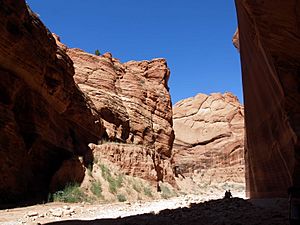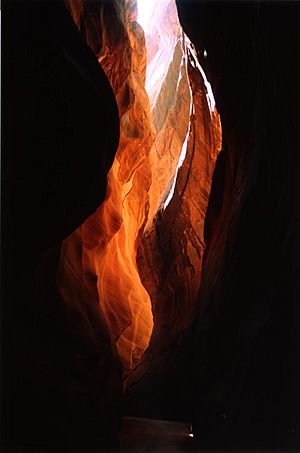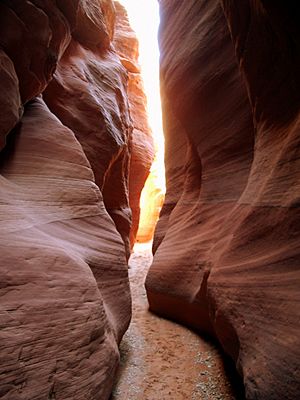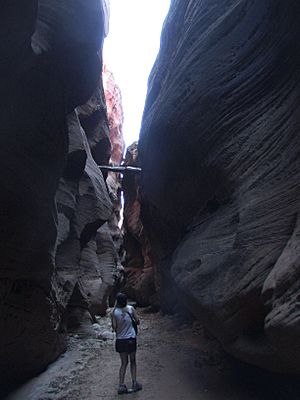Buckskin Gulch facts for kids

Buckskin Gulch is an amazing slot canyon in southern Utah, close to the Arizona border. It's also known as Buckskin Creek, Buckskin Wash, or Kaibab Gulch. This incredible canyon is a major branch of the Paria River, which eventually flows into the famous Colorado River.
At over 13 miles (21 km) long, Buckskin Gulch is the longest and deepest slot canyon in the Southwestern United States. Some even think it might be the longest in the entire world! Because it's so unique, many hikers and adventurers love to visit it.
You can explore Buckskin Gulch on its own or as part of a longer trip through Paria Canyon. Hiking both canyons can be a long adventure, about 20 miles (32 km) in total. A shorter, very popular option is to hike through Wire Pass. This is a smaller canyon that leads right into Buckskin Gulch. It lets you see the narrow, winding beauty of a slot canyon without needing a super long hike.
Contents
Getting to Buckskin Gulch
Buckskin Gulch is located between the towns of Kanab, Utah, and Page, Arizona. You can reach it from either U.S. Route 89 in Utah or U.S. Route 89A in Arizona. There are a few different ways to get into the canyon.
Wire Pass Trailhead
The Wire Pass Trailhead is the most popular way to start your adventure. It's about 8 miles (13 km) south of US‑89 on House Rock Valley Road. This entrance gives you the quickest way to see the most exciting parts of Buckskin Gulch. It's also the same starting point for visiting The Wave, a very famous rock formation. Remember, you need a separate permit for The Wave! Restrooms are available here.
Other Ways to Enter
There are other trailheads too, like the Buckskin Trailhead and the White House Trailhead. These are also found off US‑89 or US‑89A. You can also reach Buckskin Gulch by hiking through Paria Canyon, starting from Lees Ferry. This is a longer journey, but it offers a different perspective of the area.
Rules and Permits
To protect Buckskin Gulch and the surrounding Paria Canyon-Vermilion Cliffs Wilderness, you need a permit to hike or camp there. These permits help manage the number of visitors and keep the area beautiful. You can get permits online from the Bureau of Land Management (BLM).
Because Buckskin Gulch is so popular, permits often sell out months ahead of time. Day-use permits cost $6.00 per person per day. If you want to camp overnight, it's $5.00 per person per day. Only twenty overnight permits are given out each day, and groups can have up to ten people. If you bring your dog, there's a $6.00 fee per day for them too.
To keep the canyon clean, campfires are not allowed. Also, any human waste must be packed out. This means you can't bury it, but must carry it out with you.
Staying Safe in the Canyon
Hiking in Buckskin Gulch can be very challenging, but it's an amazing experience! You usually don't need special climbing gear like ropes for rappelling. However, you might need to wade through water or mud that can be ankle-deep or even chest-high. There's also one spot with a 15-foot (4.6 m) drop-off that usually has a rope to help you down. Watch out for small areas of quicksand too!
The canyon can be much colder than the desert outside because very little sunlight reaches the bottom. Always be prepared for cooler temperatures.
Flash Floods
One of the biggest dangers in slot canyons like Buckskin Gulch is flash floods. These are sudden, powerful floods that can happen very quickly. Even if it's sunny where you are, a storm as far as 50 miles (80 km) away can send a wall of water, sometimes 100-foot (30 m)-high, rushing down the narrow canyon. Hikers have sadly been killed in these events. Always check the weather forecast for the entire area, not just where you are, before entering a slot canyon.




